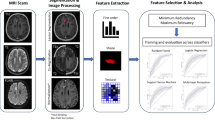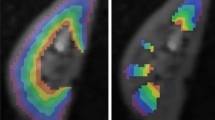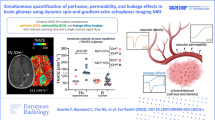Abstract
Introduction
Susceptibility-weighted imaging (SWI) with high- and ultra-high-field magnetic resonance is a very helpful tool for evaluating brain gliomas and intratumoral structures, including microvasculature. Here, we test whether objective quantification of intratumoral SWI patterns by applying fractal analysis can offer reliable indexes capable of differentiating glial tumor grades.
Methods
Thirty-six patients affected by brain gliomas (grades II–IV, according to the WHO classification system) underwent MRI at 7 T using a SWI protocol. All images were collected and analyzed by applying a computer-aided fractal image analysis, which applies the fractal dimension as a measure of geometrical complexity of intratumoral SWI patterns. The results were subsequently statistically correlated to the histopathological tumor grade.
Results
The mean value of the fractal dimension of the intratumoral SWI patterns was 2.086 ± 0.413. We found a trend of higher fractal dimension values in groups of higher histologic grade. The values ranged from a mean value of 1.682 ± 0.278 for grade II gliomas to 2.247 ± 0.358 for grade IV gliomas (p = 0.013); there was an overall statistically significant difference between histopathological groups.
Conclusion
The present study confirms that SWI at 7 T is a useful method for detecting intratumoral vascular architecture of brain gliomas and that SWI pattern quantification by means of fractal dimension offers a potential objective morphometric image biomarker of tumor grade.



Similar content being viewed by others
Abbreviations
- FD:
-
Fractal dimension
- FDSWI :
-
Fractal dimension of the intratumoral SWI pattern
- WHO:
-
World Health Organization
References
Jain RK et al (2007) Angiogenesis in brain tumors. Nat Rev Neurosci 8:610–622
Louis DN et al (2007) The 2007 WHO classification of tumours of the central nervous system. Acta Neuropathol 114:97–109
Di Ieva A et al (2011) Angioarchitectural heterogeneity in human glioblastoma multiforme: a fractal-based histopathological assessment. Microvasc Res 81:222–230
Folkert RD (2000) Descriptive analysis and quantification of angiogenesis in human brain tumors. J Neurooncol 50:165–172
Birner P et al (2003) Vascular patterns in glioblastoma influence clinical outcome and associate with variable expression of angiogenic proteins: evidence for distinct angiogenic subtypes. Brain Pathol 13:133–143
Van den Bent MJ (2010) Intraobserver variation of the histopathological diagnosis in clinical trials on gliomas: a clinician's perspective. Acta Neuropathol 120:297–304
Essig M et al (2011) MR imaging of neoplastic central nervous system lesions: review and recommendations for current practice. AJNR Am J Neuroradiol. doi:10.3174/ajnr.A2640
Robinson RJ, Bhuta S (2011) Susceptibility-weighted imaging of the brain: current utility and potential applications. J Neuroimaging 21:189–204
Haacke EM et al (2004) Susceptibility weighted imaging (SWI). Magn Reson Med 52:612–618
Li C et al (2009) Susceptibility-weighted imaging in grading brain astrocytomas. Eur J Radiol 75:87–95
Rauscher A et al (2005) Magnetic susceptibility-weighted MR phase imaging of the human brain. AJNR Am J Neuroradiol 26:737–742
Rauscher A et al (2005) High resolution susceptibility weighted MR-imaging of brain tumors during the application of a gaseous agent. Rofo 177:1065–1069
Rauscher A et al (2005) Noninvasive assessment of vascular architecture and function during modulated blood oxygenation using susceptibility weighted magnetic resonance imaging. Magn Reson Med 54:87–95
Moenninghoff C et al (2010) Imaging of adult astrocytic brain tumors with 7T MRI: preliminary results. Eur Radiol 20:704–713
Pinker K et al (2007) High-resolution contrast-enhanced, susceptibility-weighted MR imaging at 3 T in patients with brain tumors: correlation with positron-emission tomography and histopathologic findings. AJNR Am J Neuroradiol 28:1280–1286
Hori M et al (2010) Precontrast and postcontrast susceptibility-weighted imaging in the assessment of intracranial brain neoplasms at 1.5 T. Jpn J Radiol 28:299–304
Hori M et al (2010) Three-dimensional susceptibility-weighted imaging at 3T using various image analysis methods in the estimation of grading intracranial gliomas. Magn Reson Med 28:594–598
Kim HS et al (2009) Added value and diagnostic performance of intratumoral susceptibility signals in the differential diagnosis of solitary enhancing brain lesions: preliminary study. AJNR Am J Neuroradiol 30:1574–1579
Theysohn JM et al (2008) Subjective acceptance of 7 Tesla MRI for human imaging. MAGMA 21:63–72
Di Ieva A et al (2012) Fractal analysis of the susceptibility weighted imaging patterns in malignant brain tumors during antiangiogenic treatment: technical report on four cases serially imaged by 7 T magnetic resonance during a period of four weeks. World Neurosurg. doi:10.1016/jwneu.2011.09.006
Losa GA (2009) The fractal geometry of life. Riv Biol 102:29–59
Cho ZH et al (2008) Observation of the lenticulostriate arteries in the human brain in vivo using 7.0 T MR angiography. Stroke 39:1604–1606
Conijn MM et al (2009) Perforating arteries originating from the posterior communicating artery: a 7.0-Tesla MRI study. Eur Radiol 19:2986–2992
Lupo JM et al (2009) GRAPPA-based susceptibility-weighted imaging of normal volunteers and patients with brain tumor at 7 T. Magn Reson Imaging 27:480–488
von Morze C et al (2007) Intracranial time-of-flight MR angiography at 7 T with comparisons to 3 T. J Mag Reson Imaging 26:900–904
Di Ieva A et al (2011) The veins of the nucleus dentatus: anatomical and radiological findings. NeuroImage 54:74–79
Grabner G et al (2012) Longitudinal brain imaging of five malignant glioma patients treated with bevacizumab using susceptibility-weighted magnetic resonance imaging at 7 T. Magn Reson Imaging 30:139–147
Moser E et al (2012) T MR-from research to clinical applications? NMR Biomed 25:695–716
Sehgal V et al (2006) Susceptibility-weighted imaging to visualize blood products and improve tumor contrast in the study of brain masses. J Magn Reson Imaging 24:41–51
Zhang W et al (2010) Application of susceptibility weighted imaging in revealing intratumoral blood products and grading gliomas. J Radiol 91:485–490
Di Ieva A (2010) Angioarchitectural morphometrics of brain tumors: are there any potential histopathological biomarkers? Microvasc Res 80:522–533
Doblas S et al (2010) Glioma morphology and tumor-induced vascular alterations revealed in 7 rodent glioma models by in vivo magnetic resonance imaging and angiography. J Mag Reson Imaging 32:267–275
Jakab A et al (2011) Glioma grade assessment by using histogram analysis of diffusion tensor imaging-derived maps. Neuroradiology 53:483–491
Acknowledgments
ADI received a 2010 research grant from the Italian Society of Neurosurgery (SINch) and a 2011 Aesculap European Association of Neurosurgical Societies Laboratory Research Prize. This study was supported by the Jubiläumsfonds of the Austrian National Bank (grant no. 13457). The authors wish to thank FMEA (the Society for the Promotion of Research in Microsurgical and Endoscopic Anatomy) for funding the production of this article. We would like to give special thanks to the Virtual Fractal Lab Team (www.fractal-lab.org) for developing the software used here and for their continued technical support beyond image and fractal analyses.
Conflict of interest
We declare that we have no conflict of interest.
Author information
Authors and Affiliations
Corresponding author
Additional information
The preliminary results of this study were presented at the 59th Congress of the Italian Society of Neurosurgery (SINch) in Milan, Italy; the Research Course of the European Association of Neurosurgical Societies (EANS) in Lausanne, Switzerland; and the 16th Congress of the Italian Society of Neurooncology (AINO) in Milan, Italy.
Rights and permissions
About this article
Cite this article
Di Ieva, A., Göd, S., Grabner, G. et al. Three-dimensional susceptibility-weighted imaging at 7 T using fractal-based quantitative analysis to grade gliomas. Neuroradiology 55, 35–40 (2013). https://doi.org/10.1007/s00234-012-1081-1
Received:
Accepted:
Published:
Issue Date:
DOI: https://doi.org/10.1007/s00234-012-1081-1




